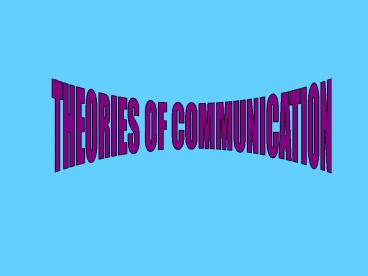Slayt 1 - PowerPoint PPT Presentation
1 / 13
Title:
Slayt 1
Description:
... the media have grown in economic value because more international media corporations is dominating the media market, the influence ... media and society ... – PowerPoint PPT presentation
Number of Views:41
Avg rating:3.0/5.0
Title: Slayt 1
1
THEORIES OF COMMUNICATION
2
The mass media (a plural form) refer to the
organized means of communicating openly, at a
distance, and to many in a short space of time.
Key features of mass communication
- They have a capacity to reach the entire
population rapidly and with - same information, opinions, and entertainment,
- They hold a universal attraction
- They can stimulate both hopes and fears in equal
degree - It is assumed that they have a great impact and
influence.
3
Related to the sphere of politics, the mass media
provide an arena of debate and a set of channels
for making policies, candidates, and ideas more
widely known and for providing politicians,
interest groups and agents of government with a
means of publicity and influence.
In the realm of culture, the mass media are the
main channel of cultural representation and
expression and the primary source of images of
social reality and materials for forming and
maintaining social identity.
Regarding the sphere of everyday social life, it
can be maintained that the mass media shape
everyday social life by means of the routines of
media use and media contents. Mass media
influence our leisure time and our lifestyles.
Gradually, the media have grown in economic value
because more international media corporations is
dominating the media market, the influence of
mass media is extending through sport, travel,
leisure, food and clothing industries, and the
mass media have interconnection with
telecommunications and all information-based
sectors.
4
There are diverse perspectives within media
theory. For example, there are significant
differences between leftist and rightist
approaches.
While leftist theory is criticizing the power
exercised by large global media corporations,
rightist or conservative theorists draw attention
to the damage done by media to traditional
values.
5
- Media-centric approach
- attributes much more autonomy and influence to
communication and concentrates on the medias own
sphere of activity. - This approach perceives media as a primary force
in social change, occurred as a result of
irresistible developments in communication
technology. - In addition, it gives special emphasis to the
specific content of media and the potential
consequences of the different kinds of media like
print, audiovisual, and interactive media.
6
- Socio-centric approach
- mainly sees the media as a reflection of
political and economic forces. So media theory is
seen as a special application of broader social
theory. - For this perspective, mass communication theory
is tending to respond to each major shift of
media technology and structure.
7
(No Transcript)
8
- A media-culturalist perspective that pays
special attention to media content and form and
the subjective reception of media messages by
audiences. - A media-materialist approach that emphasizes the
organizational, financil and technological
aspects of the media. - A social-culturalist perspective that underlines
the influence of social factors on media
production and reception and the functions media
in social life. - A social-materialist perspective that considers
media and their contents as a reflection of
political-economic and material forces and
conditions.
9
The structural approach
- Receives mainly from sociology but it also
includes perspectives from history, politics,
law, and economics. - Its starting point is socio-centric rather
than media-centric. - It deals primarily with media systems and
organization and their relationship to the wider
society.
10
The structural approach-2
- Regarding the matter of media content, the
structural approach focuses on the effects of
social structure and media systems on patterns of
content.
- Related to the media use and effect, it
emphasizes the consequences of mass communication
for other social institutions. This includes, for
instance, the influence of political marketing on
the conduct of elections or the role of news
management and public relations in government
policy.
- The main dynamics of media phenomena are located
in the exercise of power, in the economy and the
socially organized application of technology.
11
The behavioral approach
- has its principal roots in psychology and social
psychology but it also has a sociological
variation. - In general, the primary topic of this approach
is individual human behavior, especially in
relation to choosing, processing and responding
to communication messages. - The behavioral approach treats the mass media
use as a form of rational, motivated action that
has a certain function and has some objective
consequences.
12
The behavioarl approach - 2
- Psychological approaches generally use
experimental research methods based on individual
subjects.
- The sociological variant focuses on behavior of
socially defined group members and uses
multivariate analysis of representative survey
data collected in natural conditions. Individuals
are classified according to relevant variables of
social position, disposition, and behavior. In
the study of organizations, the sociological
variant of the behavioral approach adopts
participant observation method. Media texts are
analyzed by means of content analysis.
13
The cultural approach
- has its roots in the humanities, in
anthropology, and in linguistics. - This approach mainly focuses on questions of
meaning and language, details of particular
social contexts and cultural experiences.
- The study of media is part of a wider field of
cultural studies. It is more likely to be
media-centric, sensitive to differences between
media and settings of media transmission and
reception, more interested in the in-depth
understanding of particular contents and
situations than in generalization.
- It chooses the qualitative and in-depth analysis
of social and human practices and the analysis
and interpretation of texts.
- The cultural approach utilizes a wide range of
theory including feminist, philosophical,
semiotic, psychoanalytic, film and literary
studies.































